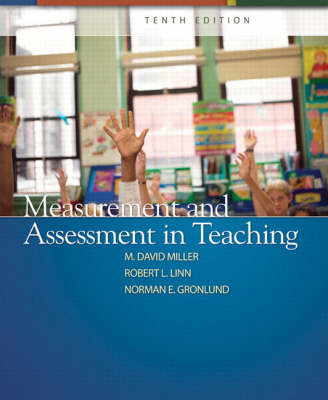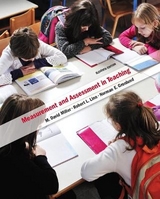
Measurement and Assessment in Teaching
Pearson (Verlag)
978-0-13-240893-6 (ISBN)
- Titel erscheint in neuer Auflage
- Artikel merken
For years, this outstanding, classic text has been the market-leader for courses in Classroom Assessment and Test and Measurement taught in Education Departments across the nation. In a presentation that assumes no previous knowledge of assessment or measurement, the text provides crystal clear step-by-step instruction on such topics as constructing test questions, aligning assessment with learning goals, and interpreting standardized tests. Providing readers with an understanding of the role of assessment in the instructional process, the book helps students learn how to construct effective test questions that are aligned with learning objectives, evaluate published tests and properly interpret scores of standardized tests. The revision has been thoroughly updated and revised to include: The changing context of testing and assessment now required to meet state and federal assessment mandates; Many new examples of classroom assessments have been added; A stronger emphasis on the development of assessments testing higher order thinking skills, such as analysis, synthesis and evaluation; Updated discussion of student motivation on standardized test; Materials on published tests reflect new editions and new approaches to assessment; Significant coverage of the Standards Movement and No Child Left Behind legislation; Detailed, straightforward guidelines for how to construct test items with many concrete examples; and Coverage of both formative and summative assessment and of all practical aspects of classroom assessment teachers need. Measurement and Assessment in Teaching, tenth edition, introduces the elements of measurement and assessment that are essential to good teaching, once again paving the way for future educators.
Highlights of the New Edition include:
Major revisions in Chapter 1 reflect the changing context of testing and assessment now required to meet state and federal assessment mandates
Many new examples of classroom assessments have been added.
Revisions in Chapter 6, Planning Classroom Tests and Assessments, give the chapter a stronger emphasis on the development of assessments testing higher order thinking skills, such as analysis, synthesis and evaluation.
The discussion of student motivation on standardized tests in Chapter 18, Test Selection, Administration, and Use, is updated.
References to many Web sites have been added or updated.
Materials on published tests reflect new editions and new approaches to assessment.
TOC
PART I THE MEASUREMENT AND ASSESSMENT PROCESS
Chapter 1 Educational Testing and Assessment: Context, Issues, and Trends
Educational Assessment: Barometer and Lever of Reform
Five Decades of Test-Based Educational Reform
Technological Advances in Testing and Assessment
Public Concern About Testing and Assessment
Chapter 2 The Role of Measurement and Assessment in Teaching
Instructional Decisions Requiring Assessment Data
Assessment, Test, and Measurement
General Principles of Assessment
Assessment and the Instructional Process
Types of Assessment Procedures
Summary of Assessment Categories
Chapter 3 Instructional Goals and Objectives: Foundation for Assessment
Instructional Objectives as Learning Outcomes
From Overly Specific Objectives to the Thinking Curriculum
Method of Stating Instructional Objectives
Chapter 4 Validity
Nature of Validity
Major Considerations in Assessment Validation
Content Considerations
Construct Considerations
Assessment-Criterion Relationships
Consideration of Consequences
Factors Influencing Validity
Chapter 5 Reliability and Other Desired Characteristics
Nature of Reliability
Determining Reliability by Correlation Methods
Standard Error of Measurement
Factors Influencing Reliability Measures
Reliability of Assessments Evaluated in Terms of a Fixed Performance Standard
Usability
PART II CLASSROOM TESTS AND ASSESSMENTS
Chapter 6 Planning Classroom Tests and Assessments
The Purpose of Classroom Testing and Assessment
Developing Specifications for Tests and Assessments
Selecting Appropriate Types of Items and Assessment Tasks
Considerations in Preparing Relevant Test Items and Assessment Tasks
Chapter 7 Constructing Objective Test Items: Simple Forms
Short-Answer Items
True-False or Alternative-Response Items
Matching Exercises
Chapter 8 Constructing Objective Test Items: Multiple-Choice Forms
Characteristics of Multiple-Choice Items
Uses of Multiple-Choice Items
Advantages and Limitations of Multiple-Choice Items
Suggestions for Constructing Multiple-Choice Items
Chapter 9 Measuring Complex Achievement: The Interpretive Exercise
Nature of the Interpretive Exercise
Forms and Uses of the Interpretive Exercise
Advantages and Limitations of Interpretive Exercises
Suggestions for Constructing Interpretive Exercises
Chapter 10 Measuring Complex Achievement: Essay Questions
Forms and Uses of Essay Questions
Summary Comparison of Learning Outcomes Measured
Advantages and Limitations of Essay Questions
Suggestions for Constructing Essay Questions
Scoring Criteria
Suggestions for Scoring Essay Questions
Chapter 11 Measuring Complex Achievement: Performance-Based Assessments
Types of Performance-Based Assessment
Advantages and Limitations of Performance Assessments
Suggestions for Constructing Performance Tasks
Performance Criteria
Scoring Rubrics and Rating Scales
Checklists
Student Participation in Rating
Chapter 12 Portfolios
What Qualifies as a Portfolio of Student Work?
Potential Strengths and Weaknesses of Portfolios
Purpose of Portfolios
Guidelines for Portfolio Entries
Guidelines and Students' Role in Selection of Portfolio Entries and Self-Evaluation
Evaluation Criteria
Using Portfolios in Instruction and Communication
Chapter 13 Assessment Procedures: Observational Techniques, Peer Appraisal, and Self-Report
Anecdotal Records
Student Judgments and Reports
Peer Appraisal
Self-Report Techniques
Attitude Measurement
Interest Inventories
Personality Measures
Chapter 14 Assembling, Administering, and Appraising Classroom Tests and Assessments
Assembling the Classroom Test
Administering and Scoring Classroom Tests and Assessments
Appraising Classroom Tests and Assessments
Building a File of Effective Items and Tasks
Chapter 15 Grading and Reporting
Functions of Grading and Reporting Systems
Types of Grading and Reporting Systems
Multiple Grading and Reporting Systems
Assigning Letter Grades
Record-Keeping and Grading Software
Conducting Parent-Teacher Conferences
Reporting Standardized Test Results to Parents
PART III SELECTING AND USING PUBLISHED TESTS
Chapter 16 Achievement Tests
Characteristics of Standardized Achievement Tests
Standardized Tests versus Informal Classroom Tests
Standardized Achievement Test Batteries
Achievement Tests in Specific Areas
Customized Achievement Tests
Individual Achievement Tests
Chapter 17 Aptitude Tests
Achievement and Aptitude Tests
Scholastic Aptitude and Learning Ability
Group Tests of Learning Ability
Individual Tests
Cautions in Interpreting and Using Learning Ability Scores
Culture-Fair Testing
Differential Aptitude Testing
Chapter 18 Test Selection, Administration, and Use
Obtaining Information About Published Tests
Selecting Appropriate Tests
Administering Published Tests
Using Results of Published Tests
Chapter 19 Interpreting Test Scores and Norms
Methods of Interpreting Test Scores
Grade Norms
Percentile Rank
Standard Scores
Profiles
Skill Analysis
Judging the Adequacy of Norms
Using Local Norms
Cautions in Interpreting Test Scores
APPENDICES
Appendix A Elementary Statistics
Appendix B Professional Journals for Locating Measurement and Assessment Articles
Appendix C Content Standards
Appendix D Standards for Teacher Competence in Educational Assessment of Students
Appendix E Test Publishers
Appendix F Selected Published Tests
Appendix G Taxonomy of Educational Objectives
Appendix H Relating Assessment Procedures to Instructional Objectives
| Erscheint lt. Verlag | 11.4.2008 |
|---|---|
| Sprache | englisch |
| Maße | 238 x 196 mm |
| Gewicht | 1018 g |
| Themenwelt | Sozialwissenschaften ► Pädagogik |
| ISBN-10 | 0-13-240893-7 / 0132408937 |
| ISBN-13 | 978-0-13-240893-6 / 9780132408936 |
| Zustand | Neuware |
| Haben Sie eine Frage zum Produkt? |
aus dem Bereich



